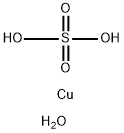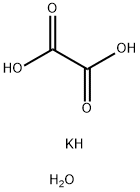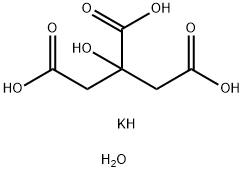Copper (II) acetate monohydrate
Synonym(s):Copper(II) acetate monohydrate;Cupric acetate;Cupric acetate monohydrate
- CAS NO.:6046-93-1
- Empirical Formula: C4H8CuO5
- Molecular Weight: 199.65
- MDL number: MFCD00149570
- EINECS: 611-978-9
- SAFETY DATA SHEET (SDS)
- Update Date: 2025-09-25 17:15:13

What is Copper (II) acetate monohydrate?
Chemical properties
Dark green small crystal with odour of acetic acid
Chemical properties
Cupric acetate is a greenish Blue powder or small crystals.
The Uses of Copper (II) acetate monohydrate
Cupric acetate monohydrate can be used in preparation of Fehling's reagent for sugars
The Uses of Copper (II) acetate monohydrate
Copper(II) acetate monohydrate is used in formation of Cu chelates of ?-dicarbonyl compounds as a means of purification and in the eglinton (modified glaser) coupling of terminal alkynes. It is also used as a catalyst for the michael reaction giving increased yields and absence of side-reactions. It Promotes ullmann-type C-O and C-N coupling reactions of arylboronic acids with phenols, amines and various other nitrogen derivatives. It is also used in biochemical applications such as DNA extraction.
The Uses of Copper (II) acetate monohydrate
Catalyst for activation of alcohols as greener alkylating reagents
Copper-Catalyzed Aerobic Oxidation of Amines to Imines under Neat Conditions with Low Catalyst Loading
What are the applications of Application
Copper (II) acetate monohydrate is used in biochemical applications such as DNA extraction
Preparation
Copper(II) acetate monohydrate can easily be produced by the reaction of acetic acid solutions with copper(II) carbonate or copper(II) hydroxide or by the reaction of copper(II) oxide with hot acetic acid. Large-scale commercial production uses copper metal in the presence of air and refluxing acetic acid.
Copper(II) acetate monohydrate is used as a catalyst in the polymerization of organic materials and as a mordant in the dying of textiles. It is also used as a ceramic pigment and as a fungicide.
General Description
Copper (II) acetate monohydrate is soluble in water and slightly soluble in methanol, diethylether and acetone. It can be synthesized by reacting acetic acid with copper (II) carbonate or copper(II) hydroxide or copper (II) oxide. Large scale commercial production is undertaken by placing copper metal in the presence of air and refluxing acetic acid. As a transition metal acetate, it can be used to form oxide nanoparticles by sonochemical methods.
Potential Exposure
Cupric acetate is used as a fungicide, as a catalyst for organic reactions; in textile dyeing and as a pigment for ceramics.
Shipping
UN3077 Environmentally hazardous substances, solid, n.o.s., Hazard class: 9; Labels: 9-Miscellaneous hazardous material, Technical Name Required.
Purification Methods
Recystallise it twice from warm dilute acetic acid solutions (5mL/g) by cooling. [Beilstein 2 IV 111.]
Incompatibilities
Forms explosive materials with acetylene gas, ammonia, caustic solutions; sodium hypobromite; notromethane. Keep away from chemically active metals; strong acids; nitrates. Decomposes above 240C forming acetic acid fumes
Waste Disposal
Copper-containing soluble wastes can be concentrated through the use of ion exchange, reverse osmosis, or evaporators to the point where copper can be electrolytically removed and sent to a reclaiming firm. If recovery is not feasible, the copper can be precipitated through the use of caustics and the sludge deposited in a chemical waste landfill.
Properties of Copper (II) acetate monohydrate
| Melting point: | 115 °C |
| Boiling point: | 240 °C |
| Density | 1.88 |
| vapor density | 6.9 (vs air) |
| storage temp. | Store at +5°C to +30°C. |
| solubility | 72g/l |
| form | Solid |
| color | Dark Green |
| Specific Gravity | 1.882 |
| PH | 5.2-5.5 (20g/l, H2O, 20℃) |
| Odor | Slight acetic acid odor |
| PH Range | 5.2 - 5.5 |
| Water Solubility | 72 g/L (20 ºC) |
| Hydrolytic Sensitivity | 0: forms stable aqueous solutions |
| Merck | 14,2624 |
| BRN | 3730548 |
| Exposure limits | ACGIH: TWA 1 mg/m3 NIOSH: IDLH 100 mg/m3; TWA 1 mg/m3 |
| Stability: | Stable. Incompatible with oxidizing agents. |
| CAS DataBase Reference | 6046-93-1(CAS DataBase Reference) |
Safety information for Copper (II) acetate monohydrate
| Signal word | Danger |
| Pictogram(s) |
 Corrosion Corrosives GHS05  Exclamation Mark Irritant GHS07  Environment GHS09 |
| GHS Hazard Statements |
H302:Acute toxicity,oral H314:Skin corrosion/irritation H410:Hazardous to the aquatic environment, long-term hazard |
| Precautionary Statement Codes |
P260:Do not breathe dust/fume/gas/mist/vapours/spray. P273:Avoid release to the environment. P280:Wear protective gloves/protective clothing/eye protection/face protection. P301+P312:IF SWALLOWED: call a POISON CENTER or doctor/physician IF you feel unwell. P303+P361+P353:IF ON SKIN (or hair): Remove/Take off Immediately all contaminated clothing. Rinse SKIN with water/shower. P305+P351+P338:IF IN EYES: Rinse cautiously with water for several minutes. Remove contact lenses, if present and easy to do. Continuerinsing. |
Computed Descriptors for Copper (II) acetate monohydrate
| InChIKey | NWFNSTOSIVLCJA-UHFFFAOYSA-L |
Copper (II) acetate monohydrate manufacturer
Cosmic Chemicals
Zama Chemical
New Products
4,4-Difluoropiperidine hydrochloride tert-butyl 9-methoxy-3-azaspiro[5.5]undecane-3-carboxylate Indole Methyl Resin N-Isopropylurea N,N-Dicyclohexylcarbodiimide(DCC) MELDRUMS ACID 5-METHYLISOXAZOLE-4-CARBOXYLIC ACID Magnessium Bis glycinate Zinc ascorbate 1-bromo-2-butyne 2-acetamidophenol 9(10H)-anthracenone Erythrosin B, 4-Piperidinopiperidine 2-((4-morpholinophenylamino) (methylthio) methylene) malononitrile 2,4-dihydroxybenzaldehyde 3-(4-morpholinophenylamino)-5-amino-1H-pyrazole-4-carbonitrile Methyl 2-methylquinoline-6-carboxylate 2,6-dichloro-4-nitropyridine 4-Bromo-2-chlorobenzonitrile 2-(benzylamino)acetic acid hydrochloride 4-(tert-Butoxycarbonylamino)but- 2-ynoic acid 3,4-dihydro-2H-benzo[b][1,4]dioxepine 1-Phenyl-1-cycloprppanecarboxylicacidRelated products of tetrahydrofuran








You may like
-
 Cupric acetate monohydrate 98%View Details
Cupric acetate monohydrate 98%View Details -
 Copper(II) acetate monohydrate 98%View Details
Copper(II) acetate monohydrate 98%View Details -
 Copper(II) acetate, monohydrate CAS 6046-93-1View Details
Copper(II) acetate, monohydrate CAS 6046-93-1View Details
6046-93-1 -
 Copper(II) acetate monohydrate, monohydrate CAS 6046-93-1View Details
Copper(II) acetate monohydrate, monohydrate CAS 6046-93-1View Details
6046-93-1 -
 Copper(II) acetate monohydrate, monohydrate CAS 6046-93-1View Details
Copper(II) acetate monohydrate, monohydrate CAS 6046-93-1View Details
6046-93-1 -
 Copper(II) acetate monohydrate CAS 6046-93-1View Details
Copper(II) acetate monohydrate CAS 6046-93-1View Details
6046-93-1 -
 Copper(II) acetate monohydrate CAS 6046-93-1View Details
Copper(II) acetate monohydrate CAS 6046-93-1View Details
6046-93-1 -
 Copper (II) Acetate MonohydrateView Details
Copper (II) Acetate MonohydrateView Details
6046-93-1
